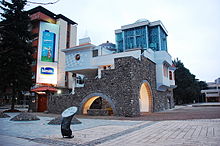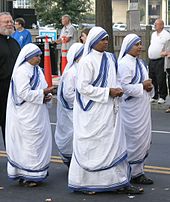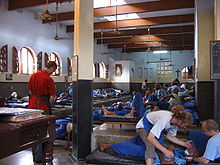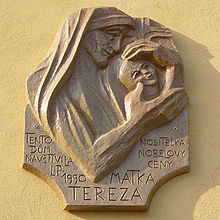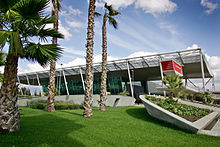
Mother Teresa
Did you know...
SOS believes education gives a better chance in life to children in the developing world too. SOS Children is the world's largest charity giving orphaned and abandoned children the chance of family life.
| Blessed Teresa of Calcutta | |
|---|---|
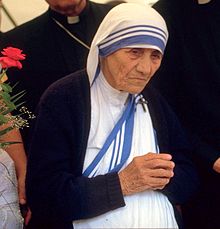 Mother Teresa at a pro-life meeting in 1986 in Bonn, West Germany |
|
| Religion | Roman Catholic |
| Order | Sisters of Loreto (1928–1950) Missionaries of Charity (1950–1997) |
| Personal | |
| Nationality | Indian |
| Born | Anjezë Gonxhe Bojaxhiu 26 August 1910 Üsküp ( Skopje), Kosovo Vilayet, Ottoman Empire |
| Died | 5 September 1997 (aged 87) Calcutta, India |
| Senior posting | |
| Title | Superior general |
| Period in office | 1950–1997 |
| Successor | Sister Nirmala |
Blessed Teresa of Calcutta, born Anjezë Gonxhe Bojaxhiu (Albanian: [aˈɲɛs ˈɡɔɲdʒa bɔjaˈdʒiu]) and commonly known as Mother Teresa (26 August 1910 – 5 September 1997), was an ethnic Albanian, Indian Roman Catholic nun.
Mother Teresa founded the Missionaries of Charity, a Roman Catholic religious congregation, which in 2012 consisted of over 4,500 sisters and is active in 133 countries. They run hospices and homes for people with HIV/AIDS, leprosy and tuberculosis; soup kitchens; children's and family counselling programmes; orphanages; and schools. Members of the order must adhere to the vows of chastity, poverty and obedience, and the fourth vow, to give "Wholehearted and Free service to the poorest of the poor".
She was the recipient of numerous honours including the 1979 Nobel Peace Prize. In late 2003, she was beatified, the third step toward possible sainthood, giving her the title "Blessed Teresa of Calcutta". A second miracle credited to Mother Teresa is required before she can be recognised as a saint by the Catholic Church. She was admired by many; in 1999, a poll of Americans ranked her first in Gallup's List of Most Widely Admired People of the 20th Century. However, she has also been criticized for failing to provide medical care or pain killers because she felt that suffering would bring people closer to Jesus, for misusing charitable monies, and for maintaining positive relationships with dictators.
Early life
Anjezë Gonxhe Bojaxhiu (gonxha meaning "rosebud" or "little flower" in Albanian) was born on 26 August 1910, but she considered 27 August, the day she was baptised, to be her "true birthday". She was born in Skopje, now capital of the Republic of Macedonia, but at the time part of the Ottoman Empire.
She was the youngest of the children of Nikollë and Dranafile Bojaxhiu (Bernai). Her father, who was involved in Albanian politics, died in 1919 when she was eight years old. After her father's death, her mother raised her as a Roman Catholic. Her father, Nikollë Bojaxhiu was possibly from Prizren, Kosovo while her mother was possibly from a village near Đakovica, Kosovo.
According to a biography by Joan Graff Clucas, in her early years Agnes was fascinated by stories of the lives of missionaries and their service in Bengal, and by age 12 was convinced that she should commit herself to a religious life. Her final resolution was taken on 15 August 1928, while praying at the shrine of the Black Madonna of Letnice, where she often went on pilgrimage.
She left home at age 18 to join the Sisters of Loreto as a missionary. She never again saw her mother or sister.
Agnes initially went to the Loreto Abbey in Rathfarnham, Ireland, to learn English, the language the Sisters of Loreto used to teach school children in India. She arrived in India in 1929, and began her novitiate in Darjeeling, near the Himalayan mountains, where she learnt Bengali and taught at the St. Teresa’s School, a schoolhouse close to her convent. She took her first religious vows as a nun on 24 May 1931. At that time she chose to be named after Thérèse de Lisieux, the patron saint of missionaries, but because one nun in the convent had already chosen that name, Agnes opted for the Spanish spelling Teresa.
She took her solemn vows on 14 May 1937, while serving as a teacher at the Loreto convent school in Entally, eastern Calcutta. Teresa served there for almost twenty years and in 1944 was appointed headmistress.
Although Teresa enjoyed teaching at the school, she was increasingly disturbed by the poverty surrounding her in Calcutta (Kolkata). The Bengal famine of 1943 brought misery and death to the city; and the outbreak of Hindu/Muslim violence in August 1946 plunged the city into despair and horror.
Missionaries of Charity
On 10 September 1946, Teresa experienced what she later described as "the call within the call" while travelling by train to the Loreto convent in Darjeeling from Calcutta for her annual retreat. "I was to leave the convent and help the poor while living among them. It was an order. To fail would have been to break the faith." As one author later noted, "Though no one knew it at the time, Sister Teresa had just become Mother Teresa".
She began her missionary work with the poor in 1948, replacing her traditional Loreto habit with a simple white cotton sari decorated with a blue border. Mother Teresa adopted Indian citizenship, spent a few months in Patna to receive a basic medical training in the Holy Family Hospital and then ventured out into the slums. Initially she started a school in Motijhil (Calcutta); soon she started tending to the needs of the destitute and starving. In the beginning of 1949 she was joined in her effort by a group of young women and laid the foundations to create a new religious community helping the "poorest among the poor".
Her efforts quickly caught the attention of Indian officials, including the prime minister, who expressed his appreciation.
Teresa wrote in her diary that her first year was fraught with difficulties. She had no income and had to resort to begging for food and supplies. Teresa experienced doubt, loneliness and the temptation to return to the comfort of convent life during these early months. She wrote in her diary:
Our Lord wants me to be a free nun covered with the poverty of the cross. Today I learned a good lesson. The poverty of the poor must be so hard for them. While looking for a home I walked and walked till my arms and legs ached. I thought how much they must ache in body and soul, looking for a home, food and health. Then the comfort of Loreto [her former order] came to tempt me. 'You have only to say the word and all that will be yours again,' the Tempter kept on saying ... Of free choice, my God, and out of love for you, I desire to remain and do whatever be your Holy will in my regard. I did not let a single tear come.
Teresa received Vatican permission on 7 October 1950 to start the diocesan congregation that would become the Missionaries of Charity. Its mission was to care for, in her own words, "the hungry, the naked, the homeless, the crippled, the blind, the lepers, all those people who feel unwanted, unloved, uncared for throughout society, people that have become a burden to the society and are shunned by everyone."
It began as a small order with thirteen members in Calcutta; by 1997 it had grown to more than 4,000 sisters running orphanages, AIDS hospices and charity centres worldwide, and caring for refugees, the blind, disabled, aged, alcoholics, the poor and homeless, and victims of floods, epidemics, and famine.
In 1952 Mother Teresa opened the first Home for the Dying in space made available by the city of Calcutta (Kolkata). With the help of Indian officials she converted an abandoned Hindu temple into the Kalighat Home for the Dying, a free hospice for the poor. She renamed it Kalighat, the Home of the Pure Heart (Nirmal Hriday). Those brought to the home received medical attention and were afforded the opportunity to die with dignity, according to the rituals of their faith; Muslims were read the Quran, Hindus received water from the Ganges, and Catholics received the Last Rites. "A beautiful death," she said, "is for people who lived like animals to die like angels—loved and wanted."
Mother Teresa soon opened a home for those suffering from Hansen's disease, commonly known as leprosy, and called the hospice Shanti Nagar (City of Peace). The Missionaries of Charity also established several leprosy outreach clinics throughout Calcutta, providing medication, bandages and food.
As the Missionaries of Charity took in increasing numbers of lost children, Mother Teresa felt the need to create a home for them. In 1955 she opened the Nirmala Shishu Bhavan, the Children's Home of the Immaculate Heart, as a haven for orphans and homeless youth.
The order soon began to attract both recruits and charitable donations, and by the 1960s had opened hospices, orphanages and leper houses all over India. Mother Teresa then expanded the order throughout the globe. Its first house outside India opened in Venezuela in 1965 with five sisters. Others followed in Rome, Tanzania, and Austria in 1968; during the 1970s the order opened houses and foundations in dozens of countries in Asia, Africa, Europe and the United States.
The Missionaries of Charity Brothers was founded in 1963, and a contemplative branch of the Sisters followed in 1976. Lay Catholics and non-Catholics were enrolled in the Co-Workers of Mother Teresa, the Sick and Suffering Co-Workers, and the Lay Missionaries of Charity. In answer to the requests of many priests, in 1981 Mother Teresa also began the Corpus Christi Movement for Priests, and in 1984 founded with Fr. Joseph Langford the Missionaries of Charity Fathers to combine the vocational aims of the Missionaries of Charity with the resources of the ministerial priesthood. By 2007 the Missionaries of Charity numbered approximately 450 brothers and 5,000 sisters worldwide, operating 600 missions, schools and shelters in 120 countries.
International charity
She said "By blood, I am Albanian. By citizenship, an Indian. By faith, I am a Catholic nun. As to my calling, I belong to the world. As to my heart, I belong entirely to the Heart of Jesus."
In 1982, at the height of the Siege of Beirut, Mother Teresa rescued 37 children trapped in a front line hospital by brokering a temporary cease-fire between the Israeli army and Palestinian guerrillas. Accompanied by Red Cross workers, she travelled through the war zone to the devastated hospital to evacuate the young patients.
When Eastern Europe experienced increased openness in the late 1980s, she expanded her efforts to Communist countries that had previously rejected the Missionaries of Charity, embarking on dozens of projects. She was undeterred by criticism about her firm stand against abortion and divorce stating, "No matter who says what, you should accept it with a smile and do your own work." She visited the Soviet republic of Armenia following the 1988 Spitak earthquake, and met with Nikolai Ryzhkov, the Chairman of the Council of Ministers.
Mother Teresa travelled to assist and minister to the hungry in Ethiopia, radiation victims at Chernobyl, and earthquake victims in Armenia. In 1991, Mother Teresa returned for the first time to her homeland and opened a Missionaries of Charity Brothers home in Tirana, Albania.
By 1996, she was operating 517 missions in more than 100 countries. Over the years, Mother Teresa's Missionaries of Charity grew from twelve to thousands serving the "poorest of the poor" in 450 centres around the world. The first Missionaries of Charity home in the United States was established in the South Bronx, New York; by 1984 the order operated 19 establishments throughout the country. Mother Teresa was fluent in five languages: Bengali, Albanian, Serbo-Croatian, English, and Hindi.
Declining health and death
Mother Teresa suffered a heart attack in Rome in 1983, while visiting Pope John Paul II. After a second attack in 1989, she received an artificial pacemaker. In 1991, after a battle with pneumonia while in Mexico, she suffered further heart problems. She offered to resign her position as head of the Missionaries of Charity, but the sisters of the order, in a secret ballot, voted for her to stay. Mother Teresa agreed to continue her work as head of the order.
In April 1996, Mother Teresa fell and broke her collar bone. In August she suffered from malaria and failure of the left heart ventricle. She had heart surgery but it was clear that her health was declining. The Archbishop of Calcutta, Henry Sebastian D'Souza, said he ordered a priest to perform an exorcism on Mother Teresa with her permission when she was first hospitalised with cardiac problems because he thought she may be under attack by the devil.
On 13 March 1997, she stepped down from the head of Missionaries of Charity. She died on 5 September 1997.
At the time of her death, Mother Teresa's Missionaries of Charity had over 4,000 sisters, and an associated brotherhood of 300 members, operating 610 missions in 123 countries. These included hospices and homes for people with HIV/AIDS, leprosy and tuberculosis, soup kitchens, children's and family counselling programs, personal helpers, orphanages, and schools. The Missionaries of Charity were also aided by Co-Workers, who numbered over 1 million by the 1990s.
Mother Teresa lay in repose in St Thomas, Kolkata for one week prior to her funeral, in September 1997. She was granted a state funeral by the Indian government in gratitude for her services to the poor of all religions in India. Her death was mourned in both secular and religious communities. In tribute, Nawaz Sharif, the Prime Minister of Pakistan said that she was "a rare and unique individual who lived long for higher purposes. Her life-long devotion to the care of the poor, the sick, and the disadvantaged was one of the highest examples of service to our humanity." The former U.N. Secretary-General Javier Pérez de Cuéllar said: "She is the United Nations. She is peace in the world."
Recognition and reception
In India
Mother Teresa had first been recognised by the Indian government more than a third of a century earlier when she was awarded the Padma Shri in 1962 and the Jawaharlal Nehru Award for International Understanding in 1969. She continued to receive major Indian awards in subsequent years, including India's highest civilian award, the Bharat Ratna, in both 1972 and 1980. Her official biography was authored by an Indian civil servant, Navin Chawla, and published in 1992.
On 28 August 2010, to commemorate the 100th anniversary of her birth, the government of India issued a special 5 Rupee coin, being the sum she first arrived in India with. President Pratibha Patil said of Mother Teresa, "Clad in a white sari with a blue border, she and the sisters of Missionaries of Charity became a symbol of hope to many – the aged, the destitute, the unemployed, the diseased, the terminally ill, and those abandoned by their families.
Indian views on Mother Teresa were not uniformly favourable. Her critic Aroup Chatterjee, who was born and raised in Calcutta but lived in London, reports that "she was not a significant entity in Calcutta in her lifetime". Chatterjee blames Mother Teresa for promoting a negative image of Calcutta, exaggerating the work done by her Mission, and misusing the funds and privileges at her disposal. Her presence and profile grated in parts of the Indian political world, as she often opposed the Hindu Right. The Bharatiya Janata Party clashed with her over the Christian Dalits, but praised her in death, sending a representative to her funeral. The Vishwa Hindu Parishad, on the other hand, opposed the government's decision to grant her a state funeral. Its secretary Giriraj Kishore said that "her first duty was to the Church and social service was incidental" and accused her of favouring Christians and conducting "secret baptisms" of the dying. But, in its front page tribute, the Indian fortnightly Frontline dismissed these charges as "patently false" and said that they had "made no impact on the public perception of her work, especially in Calcutta". Although praising her "selfless caring", energy and bravery, the author of the tribute was critical of Mother Teresa's public campaigning against abortion and that she claimed to be non-political when doing so.
In the rest of the world
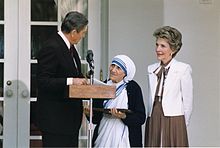
In 1962, Mother Teresa received the Philippines-based Ramon Magsaysay Award for International Understanding, given for work in South or East Asia. The citation said that "the Board of Trustees recognizes her merciful cognizance of the abject poor of a foreign land, in whose service she has led a new congregation". By the early 1970s, Mother Teresa had become an international celebrity. Her fame can be in large part attributed to the 1969 documentary Something Beautiful for God, which was filmed by Malcolm Muggeridge and his 1971 book of the same title. Muggeridge was undergoing a spiritual journey of his own at the time. During the filming of the documentary, footage taken in poor lighting conditions, particularly the Home for the Dying, was thought unlikely to be of usable quality by the crew. After returning from India, however, the footage was found to be extremely well lit. Muggeridge claimed this was a miracle of "divine light" from Mother Teresa herself. Others in the crew thought it was due to a new type of ultra-sensitive Kodak film. Muggeridge later converted to Catholicism.
Around this time, the Catholic world began to honour Mother Teresa publicly. In 1971, Paul VI awarded her the first Pope John XXIII Peace Prize, commending her for her work with the poor, display of Christian charity and efforts for peace. She later received the Pacem in Terris Award (1976). Since her death, Mother Teresa has progressed rapidly along the steps towards sainthood, currently having reached the stage of having been beatified.
Mother Teresa was honoured by both governments and civilian organisations. She was appointed an honorary Companion of the Order of Australia in 1982, "for service to the community of Australia and humanity at large." The United Kingdom and the United States each repeatedly granted awards, culminating in the Order of Merit in 1983, and honorary citizenship of the United States received on 16 November 1996. Mother Teresa's Albanian homeland granted her the Golden Honour of the Nation in 1994. Her acceptance of this and another honour granted by the Haitian government proved controversial. Mother Teresa attracted criticism from a number of people for implicitly giving support to the Duvaliers and to corrupt businessmen such as Charles Keating and Robert Maxwell. In Keating's case she wrote to the judge of his trial asking for clemency to be shown.
Universities in both the West and in India granted her honorary degrees. Other civilian awards include the Balzan Prize for promoting humanity, peace and brotherhood among peoples (1978), and the Albert Schweitzer International Prize (1975).
In 1979, Mother Teresa was awarded the Nobel Peace Prize, "for work undertaken in the struggle to overcome poverty and distress, which also constitutes a threat to peace." She refused the conventional ceremonial banquet given to laureates, and asked that the $192,000 funds be given to the poor in India, stating that earthly rewards were important only if they helped her help the world's needy. When Mother Teresa received the prize, she was asked, "What can we do to promote world peace?" She answered "Go home and love your family." Building on this theme in her Nobel Lecture, she said: "Around the world, not only in the poor countries, but I found the poverty of the West so much more difficult to remove. When I pick up a person from the street, hungry, I give him a plate of rice, a piece of bread, I have satisfied. I have removed that hunger. But a person that is shut out, that feels unwanted, unloved, terrified, the person that has been thrown out from society—that poverty is so hurtable [sic] and so much, and I find that very difficult." She also singled out abortion as 'the greatest destroyer of peace in the world'.
During her lifetime, Mother Teresa was named 18 times in the yearly Gallup's most admired man and woman poll as one of the ten women around the world that Americans admired most, finishing first several times in the 1980s and 1990s. In 1999, a poll of Americans ranked her first in Gallup's List of Most Widely Admired People of the 20th Century. In that survey, she out-polled all other volunteered answers by a wide margin, and was in first place in all major demographic categories except the very young.
Criticism
Towards the end of her life, Mother Teresa attracted some negative attention in the Western media. The journalist Christopher Hitchens was one of her most active critics. He was commissioned to co-write and narrate the documentary Hell's Angel about her for the British Channel 4 after Aroup Chatterjee encouraged the making of such a programme, although Chatterjee was unhappy with the "sensationalist approach" of the final product. Hitchens expanded his criticism in a 1995 book, The Missionary Position.
Chatterjee writes that while she was alive Mother Teresa and her official biographers refused to collaborate with his own investigations and that she failed to defend herself against critical coverage in the Western press. He gives as examples a report in The Guardian in Britain whose "stringent (and quite detailed) attack on conditions in her orphanages ... [include] charges of gross neglect and physical and emotional abuse", and another documentary Mother Teresa: Time for Change? broadcast in several European countries.
The German magazine Stern published a critical article on the first anniversary of Mother Teresa's death. This concerned allegations regarding financial matters and the spending of donations. The medical press has also published criticism of her, arising from very different outlooks and priorities on patients' needs. Other critics include Tariq Ali of the New Left Review and the Irish investigative journalist Donal MacIntyre.
She has also been criticised for her view on suffering. She felt that suffering would bring people closer to Jesus. Sanal Edamaruku, President of Rationalist International, criticised the failure to give painkillers, writing that in her Homes for the Dying, one could "hear the screams of people having maggots tweezered from their open wounds without pain relief. On principle, strong painkillers were not administered even in severe cases. According to Mother Teresa's philosophy, it is 'the most beautiful gift for a person that he can participate in the sufferings of Christ'."
The quality of care offered to terminally ill patients in the Homes for the Dying has been criticised in the medical press. The Lancet and the British Medical Journal reported the reuse of hypodermic needles, poor living conditions, including the use of cold baths for all patients, and an approach to illness and suffering that precluded the use of many elements of modern medical care, such as systematic diagnosis. Dr. Robin Fox, editor of The Lancet, described the medical care as "haphazard", as volunteers without medical knowledge had to make decisions about patient care, because of the lack of doctors. He observed that her order did not distinguish between curable and incurable patients, so that people who could otherwise survive would be at risk of dying from infections and lack of treatment. Dr. Fox makes it a point to contrast the term " hospice", on the one hand, with what he calls "Mother Teresa's Care for the Dying" on the other hand; noting that, while hospice emphasises minimising suffering with professional medical care and attention to expressed needs and wishes of the patient, her approach does not.
Colette Livermore, a former Missionary of Charity, describes her reasons for leaving the order in her book Hope Endures: Leaving Mother Teresa, Losing Faith, and Searching for Meaning. Livermore found what she called Mother Teresa's "theology of suffering" to be flawed, despite being a good and courageous person. Though Mother Teresa instructed her followers on the importance of spreading the Gospel through actions rather than theological lessons, Livermore could not reconcile this with some of the practices of the organization. Examples she gives include unnecessarily refusing to help the needy when they approached the sisters at the wrong time according to the prescribed schedule, discouraging sisters from seeking medical training to deal with the illnesses they encountered (with the justification that God empowers the weak and ignorant), and imposition of "unjust" punishments, such as being transferred away from friends. Livermore says that the Missionaries of Charity "infantilized" its sisters by prohibiting the reading of secular books and newspapers, and emphasizing obedience over independent thinking and problem-solving.
Hitchens and Stern have said Mother Teresa did not focus donated money on alleviating poverty or improving the conditions of her hospices, but on opening new convents and increasing missionary work. Mother Teresa accepted donations from the autocratic and corrupt Duvalier family in Haiti and openly praised them. She accepted $1.25 million from Charles Keating, involved in the fraud and corruption scheme known as the Keating Five scandal. The Deputy District Attorney for Los Angeles, Paul Turley, wrote to Mother Teresa asking her to return the donated money to the people Keating had stolen from, one of whom was "a poor carpenter". The donated money was not accounted for, and Turley did not receive a reply.
A study conducted by Canadian researches claimed that Mother Teresa was "anything but a saint" and was a creation of an orchestrated and effective media campaign. Study published in the journal of studies in religion/sciences called Religieuses,said that Teresa felt it was beautiful to see the poor suffer. It added that Vatican overlooked the crucial human side of Teresa and her dubious way of caring for the sick by glorifying their suffering instead of relieving it.
Spiritual life
Analyzing her deeds and achievements, John Paul II asked: "Where did Mother Teresa find the strength and perseverance to place herself completely at the service of others? She found it in prayer and in the silent contemplation of Jesus Christ, his Holy Face, his Sacred Heart." Privately, Mother Teresa experienced doubts and struggles over her religious beliefs which lasted nearly 50 years until the end of her life, during which "she felt no presence of God whatsoever", "neither in her heart or in the eucharist" as put by her postulator Rev. Brian Kolodiejchuk. Mother Teresa expressed grave doubts about God's existence and pain over her lack of faith:
Where is my faith? Even deep down ... there is nothing but emptiness and darkness ... If there be God—please forgive me. When I try to raise my thoughts to Heaven, there is such convicting emptiness that those very thoughts return like sharp knives and hurt my very soul ... How painful is this unknown pain—I have no Faith. Repulsed, empty, no faith, no love, no zeal, ... What do I labor for? If there be no God, there can be no soul. If there be no soul then, Jesus, You also are not true.
With reference to the above words, the Rev. Brian Kolodiejchuk, her postulator (the official responsible for gathering the evidence for her sanctification) indicated there was a risk that some might misinterpret her meaning, but her faith that God was working through her remained undiminished, and that while she pined for the lost sentiment of closeness with God, she did not question his existence. and that she may have experienced something similar to what is believed of Jesus Christ when crucified who was heard to say "Eli Eli lama sabachthani?" which is translated to "My God, My God, why have you forsaken me?" Many other saints had similar experiences of spiritual dryness, or what Catholics believe to be spiritual tests ("passive purifications"), such as Mother Teresa's namesake, St. Therese of Lisieux, who called it a "night of nothingness." Contrary to the mistaken belief by some that the doubts she expressed would be an impediment to canonisation, just the opposite is true; it is very consistent with the experience of canonised mystics.
Mother Teresa described, after ten years of doubt, a short period of renewed faith. At the time of the death of Pope Pius XII in the fall of 1958, praying for him at a requiem mass, she said she had been relieved of "the long darkness: that strange suffering." However, five weeks later, she described returning to her difficulties in believing.
Mother Teresa wrote many letters to her confessors and superiors over a 66-year period. She had asked that her letters be destroyed, concerned that "people will think more of me—less of Jesus." However, despite this request, the correspondences have been compiled in Mother Teresa: Come Be My Light (Doubleday). In one publicly released letter to a spiritual confidant, the Rev. Michael van der Peet, she wrote, "Jesus has a very special love for you. [But] as for me, the silence and the emptiness is so great, that I look and do not see,—Listen and do not hear—the tongue moves [in prayer] but does not speak ... I want you to pray for me—that I let Him have [a] free hand."
Many news outlets have referred to Mother Teresa's writings as an indication of a "crisis of faith." Christopher Hitchens wrote: "So, which is the more striking: that the faithful should bravely confront the fact that one of their heroines all but lost her own faith, or that the Church should have gone on deploying, as an icon of favorable publicity, a confused old lady who it knew had for all practical purposes ceased to believe?" However, others such as Brian Kolodiejchuk, Come Be My Light's editor, draw comparisons to the 16th century mystic St. John of the Cross, who coined the term the " dark night of the soul" to describe a particular stage in the growth of some spiritual masters. The Vatican has indicated that the letters would not affect her path to sainthood. In fact, the book is edited by the Rev. Kolodiejchuk, her postulator.
In his first encyclical Deus Caritas Est, Benedict XVI mentioned Teresa of Calcutta three times and he also used her life to clarify one of his main points of the encyclical. "In the example of Blessed Teresa of Calcutta we have a clear illustration of the fact that time devoted to God in prayer not only does not detract from effective and loving service to our neighbour but is in fact the inexhaustible source of that service." Mother Teresa specified that "It is only by mental prayer and spiritual reading that we can cultivate the gift of prayer."
Although there was no direct connection between Mother Teresa's order and the Franciscan orders, she was known as a great admirer of St. Francis of Assisi. Accordingly, her influence and life show influences of Franciscan spirituality. The Sisters of Charity recite the peace prayer of St. Francis every morning during thanksgiving after Communion and many of the vows and emphasis of her ministry are similar. St. Francis emphasised poverty, chastity, obedience and submission to Christ. He also devoted much of his own life to service of the poor, especially lepers in the area where he lived.
Miracle and beatification
| Blessed Teresa of Calcutta | |
|---|---|
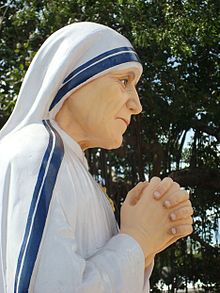 Bl. Mother Teresa Statue in St. Thomas Mount |
|
| Honored in | Roman Catholicism |
| Beatified | 19 October 2003, St. Peter's Basilica, Rome by Pope John Paul II |
| Major shrine | Mother House of the Missionaries of Charity, Calcutta (Kolkata), West Bengal, India |
| Feast | 5 September |
| Patronage | World Youth Day |
After Mother Teresa's death in 1997, the Holy See began the process of beatification, the third step toward possible canonisation. This process requires the documentation of a miracle performed from the intercession of Mother Teresa.
In 2002, the Vatican recognised as a miracle the healing of a tumor in the abdomen of an Indian woman, Monica Besra, after the application of a locket containing Mother Teresa's picture. Besra said that a beam of light emanated from the picture, curing the cancerous tumor. Critics—including some of Besra's medical staff and, initially, Besra's husband—said that conventional medical treatment had eradicated the tumor. Dr. Ranjan Mustafi, who told The New York Times he had treated Besra, said that the cyst was not cancer at all but a cyst caused by tuberculosis. He said, "It was not a miracle.... She took medicines for nine months to one year." According to Besra's husband, "My wife was cured by the doctors and not by any miracle."
An opposing perspective of the claim is that Besra's medical records contain sonograms, prescriptions, and physicians' notes that could prove whether the cure was a miracle or not. Besra has claimed that Sister Betta of the Missionaries of Charity is holding them. The publication has received a "no comments" statement from Sister Betta. The officials at the Balurghat Hospital where Besra was seeking medical treatment have claimed that they are being pressured by the Catholic order to declare the cure a miracle.
In the process of examining Teresa's suitability for beatification and canonisation, the Roman Curia (the Vatican) pored over a great deal of documentation of published and unpublished criticism of her life and work. Vatican officials say Hitchens's allegations have been investigated by the agency charged with such matters, the Congregation for the Causes of Saints, and they found no obstacle to Mother Teresa's beatification. Because of the attacks she has received, some Catholic writers have called her a sign of contradiction. The beatification of Mother Teresa took place on 19 October 2003, thereby bestowing on her the title " Blessed." A second miracle is required for her to proceed to canonisation.
Legacy and depictions in popular culture
Commemoration
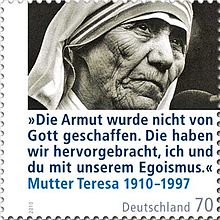
Mother Teresa inspired a variety of commemorations. She has been memorialised through museums, been named patroness of various churches, and had various structures and roads named after her, including Albania's international airport. Mother Teresa Day (Dita e Nënë Terezës) on 19 October is a public holiday in Albania. In 2009 the Memorial House of Mother Teresa was opened in her hometown Skopje, in the Republic of Macedonia. The cathedral of Pristina, in Kosovo, currently under construction, was dedicated in her honour as well.
Mother Teresa Women's University, Kodaikanal, Tamil Nadu, has been established in 1984 as a public university by government of Tamil Nadu, India.
Mother Theresa Post Graduate and Research Institute of Health Sciences, Pondicherry has been established in 1999 by Government of Puducherry, India.
Various tributes have been published in Indian newspapers and magazines authored by her biographer, Navin Chawla.
Indian Railways introduced a new train, "Mother Express", named after Mother Teresa, on 26 August 2010 to mark her birth centenary.
The Tamil Nadu State government organised centenary celebrations of Mother Teresa on 4 December 2010 in Chennai, headed by Tamil Nadu chief minister M Karunanidhi.
Film and literature
Mother Teresa is the subject of the 1969 documentary film and 1972 book Something Beautiful for God, a 1997 Art Film Festival award winning film starring Geraldine Chaplin called Mother Teresa: In the Name of God's Poor, a 2003 Italian miniseries titled Mother Teresa of Calcutta, (which was re-released in 2007 and received a CAMIE award,) and was portrayed by Megan Fox in a satirical film-within-a-film in the 2007 movie How to Lose Friends and Alienate People. Hitchens' 1994 documentary about her, Hell's Angel, claims that she urged the poor to accept their fate, while the rich are portrayed as being favoured by God.
